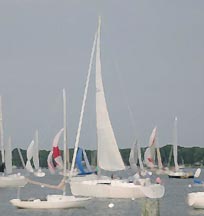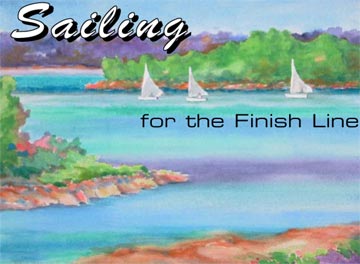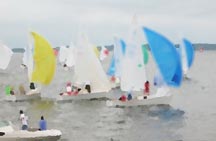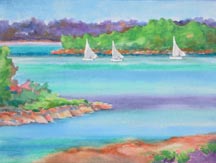 |
||||||||||
|
Volume 12, Issue 30 ~ July 22-28, 2004
|
||||||||||
|
by Maureen Miller In and around Chesapeake Country, every Wednesday from April through September, folks are leaving work early with the excuse, “I gotta race.”
Whether at a lake or on Chesapeake Bay, Wednesday night races have become a tradition for sailors across the country and around the world. Where did it all begin? And who started the Wednesday night racing tradition? In Annapolis, it’s legend that in 1959, Annapolis Yacht Club sailor Gaither Scott — who had watched Wednesday night races at East Greenwich Yacht Club in Rhode Island — imported the idea. At the Pirates Cove Racing Club in Galesville, Wednesday night racing goes back to the late 1960s or early ’70s — if memory serves. Joe Chuchla, skipper of Panache, says he was told that “the starting gun for those early races was someone taking their .38 Special and firing it into the water.” Don Wagner, skipper of Der Baron, recalls that the early starting system was made from old spare NASA mechanical launch timers, assembled by a guy named Carl, who was also building his own concrete boat in a backyard in Savage. Down on Solomons Island, Skip Zahniser, owner of Zahniser’s Yachting Center, remembers that Wednesday night racing started as an impromptu staff get-together at the marina in the late ’70s. Management of the races was transferred eventually to the Southern Maryland Sailing Association, and the races became a bit more sedate. Whatever its origin, Wednesday night racing seems to be a good idea that spread. In the early years, many races were loose and strictly for the fun of it. “The very early races were more shenanigans,” Zahniser recalls, “where we had lots of water fights and did crazy things — like having someone jump overboard as you rounded a buoy.” Big Boats and Plenty Fun is still the main reason sailors race Wednesday nights. Another is the chance for owners of big boats to compete. Dick Heinz, who’s been racing boats named Yellow Bird with the Pirates Cove club since the mid-1960s, defines a big boat as any cruising boat. “That means it has a place to sleep or just get out of the weather,” explains Heinz. At clubs in Annapolis, Galesville, Herrington Harbour at Rose Haven and in Solomons, the size of the boats competing on Wednesday nights ranges from 20 to 50 feet. “This year, boats racing in the Herrington Harbour Sailing Association Wednesday night series have ranged from 25 to 47 feet,” says Tim Richards, the association’s rear commodore in charge of racing. “Most are between 28 and 40 feet.” In Solomons, racers generally range from 24 to 35 feet. “But there’s also a 39-footer and a 48-footer named Pursuit, which more often than not leads the pack to the finish,” says Dick Devoe, a member of the Southern Maryland Sailing Association. Pursuit is a fast racing boat designed by her owners, Norm and Rosemary Dawley. The sheer number of boats in the Wednesday night series is as amazing as the boats’ sizes. This year the Wednesday night spring series, which ended in June (the summer series immediately follows) found 184 boats competing in Annapolis, 44 boats on the West River in Galesville, 21 at Herrington Harbour and 32 on the Patuxent River in Solomons.
Rules of the Race But like everything else in today’s world, things have gotten a bit more complex. To encourage the sharpening of skills, skippers and their boats compete for prizes. Prizes, in turn, entail scoring and race committees to keep score. To make the competition more equitable for the variety of boats that race, the clubs separate various craft into classes using a handicap system and a combination of race rules. Boats of a particular make and model race in the same class. Some boats will race with a spinnaker sail in addition to the mainsail. That’s the big, billowy, colored sail you see flying as the boats go downwind. These boats race in the spinnaker classes. Other boats use only a smaller jib or genoa sail along with the mainsail. They race in non-spinnaker classes. Also racing together are boats with similar handicaps. Handicaps ensure fair competition among different boats. They take into consideration a number of factors like boat weight and sail cover, but they don’t take into account factors like skipper experience or crew condition. Basically, two boats of the same make and model will have the same handicap, while those of different makes and models will have different handicaps. Der Baron’s skipper, Wagner, oversaw the handicap system for the Pirates Cove club in its early days. “We originally used a modified Portsmouth Yardstick System,” he explains. “The entire fleet, spinnaker and non-spinnaker, raced together, but we adjusted the handicap if you sailed with a spinnaker. The handicap was adjusted according to the wind direction and the length of the spinnaker leg.” Later, another system, the Performance Handicap Racing Factor, became popular and was endorsed by the group. Today all boats that race on the Bay have a PHRF rating. There’s a bit of history to this rating system. It came first from the Pacific Coast, where it was called the Pacific Handicap Racing Formula. When its use spread beyond the West Coast, the name was changed to the Performance Handicap Racing Factor. Some clubs add interesting twists to the scoring system. Clark McKinney, race governor for the Southern Maryland Sailing Association, explains how his association has made Wednesday night racing more competitive and more challenging. Bribery is part of their scheme. “If a boat gets a first, second or third place in its class on a Wednesday night, it loses three seconds per mile,” he explains. “And if a skipper and crew volunteer for race committee, they get an advantage of two seconds per mile over others in their class.” Thus a winning boat’s PHRF finish time will get debited each week, which affects its team’s final score. “This makes it more competitive and more challenging,” says McKinney, “and gives folks who may not have a good chance of winning more opportunity.” In addition to handicaps and classes, there are rules by which racers must abide. One of them appears a no-brainer: You can’t turn on your engine during the race. Once you do, you’re out. But many a Bay skipper has a sad story about having to drop out of a race because the boat got stuck on a shoal and the only way off was to fire up the engine.  Also, you have to round the marks (or buoys) the right way. For example, your racecourse might be listed as start to X; X to port to Y; Y to starboard to finish. That means that from the starting line you head toward the mark designated as X. You sail around the X mark, keeping it on the port or left side of your boat. Then you sail toward the mark designated as Y. When you round it, keep it on the starboard or right side of your boat. Then you head to the finish line. Also, you have to round the marks (or buoys) the right way. For example, your racecourse might be listed as start to X; X to port to Y; Y to starboard to finish. That means that from the starting line you head toward the mark designated as X. You sail around the X mark, keeping it on the port or left side of your boat. Then you sail toward the mark designated as Y. When you round it, keep it on the starboard or right side of your boat. Then you head to the finish line.Additionally, sailboat racing is governed by the International Sailing Federation. Every four years, this group revises its rulebook covering various rules. The most important of these are the right-of-way rules, which apply when two or more boats meet on a racecourse and which work to minimize damage and injury. Other traditions influence scoring for each race and each series. Many skippers and their crew come from Washington or other areas distant from the Bay. Thus many clubs provide for conditions like traffic jams, thunderstorms or having to stay late at work by allowing a boat to miss a race or two yet still win the series. Each boat is allowed to throw out a specified number of races. Classes, handicaps, rules and traditions all make for a complicated scoring system. “The scoring is so complex, it’s like working with differential equations,” says Peter Bell, handicapper of Pirates Cove club’s race committee. “And for that reason we use computers to determine who won the race and the series.” Who’s the Crew? Wednesday night race crews are as varied as you can get. People come from a vast cross-section of professions and lifestyles. Uniting them is their liking the feel of the wind on their face and the sounds of the water in their ears. “There are four on our boat,” says Nan Irey, who races on Wave Length. “Charlie works in the computer field with a government contractor. Mike works at Hartge’s Yacht Yard. Tad is in computers too, I think. And me, I am an independent consultant, involved in training and development for financial institutions.” Other boats are family affairs. “We raced for years with mostly all family or regular family friends,” explains Der Baron skipper Wagner, who’s competed in the Pirates Cove series since 1973, originally on Red Baron, and since 1986 on a C&C 41, Der Baron. “The children are now grown and they still come whenever possible, but with seven granddaughters enrolled in the West River Junior Sailing Program, I expect to have a significant family crew soon.” Shawn Stanley, who races in Solomons with his stepfather, wife and daughter on a Tartan 3000 named Synergy, finds Wednesday nights “a great time to hang out with the family while doing something fun and recreational.” Doyle, the RN who crews on Hannah Brown, crews with a number of retired professionals as well as an artist, a government consultant and a 14-year-old aspiring sailor, the great nephew of the skipper. As the number of crew on Hannah Brown vary from seven to 12 depending on the week, Doyle doesn’t mind that she doubles as pit tactician and beer wench. Richards and his wife, Meg Clarke, join their boat’s co-owner, Joe Black, racing their Catalina 30, Evening Tide, in the Herrington Harbour non-spinnaker class. “Sailing and racing were always part of my life in the summers when I was growing up,” Richards says. “This is a nice way to bring that experience back into my life. I love the level of focus and the requirement to feel the boat that racing requires.” He also enjoys the other racers. “We compete hard on the course, but we are doing it to have fun, and we enjoy getting together after the races,” says the five-year Wednesday night racer. The reward is even greater for Donna Schlegel of Hartge’s Yacht Yard, who says she lives to race. Most Wednesdays you’ll find her and her husband, along with a son or friend, aboard their Melges 24 Bufflehead in the Pirates Cove races.
You don’t need a boat to race on Wednesday nights. Many skippers are looking for crew. Crew don’t need to be strong. They don’t necessarily even need to know how to sail. But they must be willing to learn, ready to work and quick to listen. Many skippers will take novices who meet the above criteria — and who show up consistently on Wednesday nights. To find a boat, you can hang out on the dock and ask skippers if they need extra crew. Or you can sign up on an Internet crew list. Jennifer Beck-Merryman, who makes the trip from Old Town Alexandria to Galesville on Wednesday nights to race her boat Battle Cat, says she walked the docks in Annapolis on Wednesday nights to find her first crew job. “It was a great experience that led me to buying my own boat four or five years ago,” she says. “Once I had my own boat, I asked my best friend to be my first mate. She had never sailed before, but she learned very quickly. All of my crew have started as novices.” Most of Beck-Merryman’s crew are women, though, she says, “we have been known to take a token guy on board from time to time.” If you want to race on the West River, walk the docks at the Pirates Cove, Hartge’s or the West River marinas. In Solomons, head to Calvert Marina or Zahniser’s early Wednesday evening. The Herrington Harbour Sailing Association makes its matches on-line at www.hhsa.org. The local sailing magazine SpinSheet features a Crew List on its website as a free service “to match Chesapeake boat owners and skippers looking for crew with Bay sailors looking for a ride.”
Crossing the Finish Line The sun is setting, and the races are ending. Depending on the winds and the course, colorful spinnakers may be flying. Up in Annapolis, the cannon booms as 100-plus boats descend on the finish line in front of the Spa Creek drawbridge. As each boat crosses the finish, race committee members call off sail numbers. With so many boats, the race needs many eyes. Annapolis Yacht Club’s race committee draws from two dozen members, and it’s common for three or more to officiate on a Wednesday night. One is Bobby Fry, who travels the East Coast serving on race committees. He gives another proof that Annapolis is the nation’s sailing capital: It’s home to “one-third of all race officers in the country.” Down in Galesville, an air horn signals the first boat in each class across the finish line. In Solomons, the same 12-gauge s
Crew hurry to lower and store the sails and coil sheets and to tidy up, while skippers maneuver boats back to their slips. Some crew head straight home to be ready for work on Thursday. Others pile into the local restaurants to grab a bite and hold on a bit longer to the thrill of being out on the Bay together. “After the races we gather at Calypso Bay restaurant near Herrington Harbour North,” says Richards. “We calculate race results right there. Eric Miller, who is our rear commodore for communications, now brings a printer so racers can take a copy home with them.” At Zahniser’s, skippers and crew congregate at the poolside bar for snacks and drinks and to talk over the evening and see who’s won a glass. The association gives a highball glass bearing the legend Zahniser’s Wednesday Night Races to the first-, second- and third-place winners each week. “At the end of the series, we have a party and recognize the boat that won the most glasses,” says McKinney. Over in Galesville, crew dig into the boaters’ buffet that Pirates Cove puts out each Wednesday night. Trading stories, some wait impatiently for the race results. Others stand at the bar, drinking the boaters’ beer special and watching a video replay of that evening’s race.  In Annapolis, the Yacht Club and nearby restaurants fill quickly with hungry and thirsty sailors. One of the favorite haunts is the Boatyard Bar & Grill, where scenes from the races are replayed on video screens. In Annapolis, the Yacht Club and nearby restaurants fill quickly with hungry and thirsty sailors. One of the favorite haunts is the Boatyard Bar & Grill, where scenes from the races are replayed on video screens.Donna Schlegel, who’s raced both in the Annapolis and Pirates Cove Wednesday night series, understands exactly why Bay sailors take a break mid-week to get out on the water and race. “You can’t compare the thrill of the finish line just before the Spa Creek Bridge in Annapolis … or the quick spinnaker takedown as the boats are all converging in limited maneuvering room just off the Yacht Club dock,” she says. “Or the loud, bursting racket of the cannon shot at sunset with the lowering of the colors and the camaraderie on the clubhouse deck for post-race celebration.” At Galesville, she says, “races are just as competitive, but offer a completely different feel. You can usually rely on smooth water and oftentimes a sunset that will take your breath away.” That’s how it is up and down the Bay — in Annapolis, on the West River, in Herring Bay, at Solomons, along the Eastern Shore and in hundreds of bodies of water across the country and around the world — as another Wednesday night at the races draws to a close. |
||||||||||
|
© COPYRIGHT 2004 by New Bay Enterprises, Inc. All rights reserved. |





